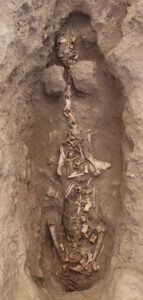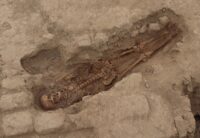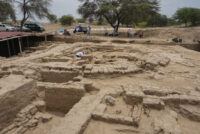 Archaeologists have discovered the remains of 29 individuals, including three children and an adolescent, in the Huaca Santa Rosa de Pucalá archaeological site in the Lambayeque region of northwestern Peru. The four young people were sacrificial offerings, buried in front of the temple when the Wari-era enclosure was built between 800 and 900 A.D. These are the first human sacrifice victims from the Wari culture that have been discovered in Lambayeque.
Archaeologists have discovered the remains of 29 individuals, including three children and an adolescent, in the Huaca Santa Rosa de Pucalá archaeological site in the Lambayeque region of northwestern Peru. The four young people were sacrificial offerings, buried in front of the temple when the Wari-era enclosure was built between 800 and 900 A.D. These are the first human sacrifice victims from the Wari culture that have been discovered in Lambayeque.
Huaca Santa Rosa de Pucalá was an important ceremonial complex, used and altered over the centuries by the Cupisnique, Mochica, Wari and Lambayeque cultures who occupied the area. The Wari temple with its characteristic D-shaped enclosure was discovered in late 2019. Follow-up excavations were derailed by the pandemic for almost two years. Archaeologists returned to work the first of September.
 Only the burials of the children and adolescent are from the Wari period. The other 25 individuals were interred in graves of pressed clay and in burial chambers in a temple from the Mochica culture. Archaeologists also found a pitcher decorated with Mochica imagery, a bottle in Early Sicán or Proto-Lambayeque style and a tumi, an Andean knife with a blade in the shape of a half moon. Remains of camelids and eight guinea pigs sacrificed for ritual purposes were unearthed as well.
Only the burials of the children and adolescent are from the Wari period. The other 25 individuals were interred in graves of pressed clay and in burial chambers in a temple from the Mochica culture. Archaeologists also found a pitcher decorated with Mochica imagery, a bottle in Early Sicán or Proto-Lambayeque style and a tumi, an Andean knife with a blade in the shape of a half moon. Remains of camelids and eight guinea pigs sacrificed for ritual purposes were unearthed as well.
The excavation has also revealed that there was a temple on the site dating back to the late Formative Period (900-200 B.C.). Built with mud brick walls with clay maces embedded inside, the construction is different from any other temple found before in Lambayeque. The upper storey of the temple had elaborate floors and ceilings made of vegetal material. There is evidence that objects were burned here, likely in ceremonial contexts.
 These discoveries rewrite the cultural history of Lambayeque. The Wari center of power was the Ayacucho area in the central Andes, so their construction of a temple so far out of their stomping grounds is evidence they had a wider sphere of influence than previously realized. The Formative Period temple was built by people with local and mountain links, indicating coastal communities interacted with mountain communities between 400 and 200 B.C.
These discoveries rewrite the cultural history of Lambayeque. The Wari center of power was the Ayacucho area in the central Andes, so their construction of a temple so far out of their stomping grounds is evidence they had a wider sphere of influence than previously realized. The Formative Period temple was built by people with local and mountain links, indicating coastal communities interacted with mountain communities between 400 and 200 B.C.
Is it just me? – Looking at the first of the “29” sacrificed, my first impression had been that this certainly must have hurt :ohnoes:
At closer inspection, however, those bones don’t even seem to be human at all, but instead as if they had been puzzled together.
I mean, just look at the vertebrae! :confused:
“Researchers also found pieces of pottery and the remains of camelids—such as llamas and alpacas—and guinea pigs.”
Not much left after dumped out of the cannibals pot I say.
Yeah, what a massive guinea pig, Tristram, eh? 😉
Indeed, “One of the 29” seems to be one of those camelids, with what appears to be two stones around its neck.
We have Llamas over here ourselves, as I much to my surprise found out recently. They make weird but rather cute noises.